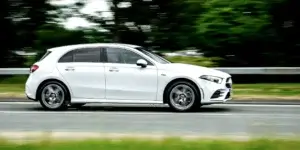What is Adaptive Cruise Control?
Adaptive cruise control (ACC) is an advanced driver assistance feature that not only maintains a set speed as traditional cruise control does but also adjusts the vehicle’s speed to keep a safe distance from the car in front. This technology is designed to reduce the stress of driving, especially on long journeys or in heavy traffic.
Some car manufacturers have their own branded versions of ACC. For instance, BMW calls it Active Cruise Control, Audi refers to it as Adaptive Cruise Assist, Mercedes-Benz names it Distronic, Lexus uses Dynamic Radar Cruise Control, Nissan has Intelligent Cruise Control, and Hyundai labels it Smart Cruise Control.

What Does Adaptive Cruise Control Do?
The key word in adaptive cruise control is ‘adaptive’. Unlike standard cruise control, which lets you set a speed and keeps it constant until you intervene, ACC adjusts the speed based on the traffic ahead. It uses sensors to detect vehicles in front and automatically accelerates or decelerates to maintain a safe following distance. This not only provides a smoother driving experience but also enhances safety by reducing the likelihood of collisions.
How Does Adaptive Cruise Control Work?
Adaptive cruise control systems use radar or laser sensors placed on the front of the car, typically in the grille or at the top of the windscreen. These sensors continually scan the road ahead to detect other vehicles. The system calculates the distance to the vehicle in front and adjusts the car’s speed accordingly.
When the road is clear, ACC maintains the set speed. If it detects a slower-moving vehicle ahead, it will reduce the speed by controlling the accelerator and brakes, maintaining a pre-set gap. Once the road is clear again, the system will accelerate back to the original speed.

How Do You Use Adaptive Cruise Control?
Using ACC is straightforward. Once you reach your desired speed, press the ‘Set’ button on your steering wheel. The system will then take over the acceleration. You can adjust the speed using the ‘+’ and ‘-‘ buttons. When the system locks onto a slower-moving vehicle, it will maintain a safe following distance that you can adjust using the controls.
ACC can be particularly useful in slow-moving traffic. Some systems are capable of bringing the car to a complete stop and then restarting it, making stop-and-go traffic much less stressful.
How Do I Know If My Car Has Adaptive Cruise Control?
Many modern cars come equipped with adaptive cruise control, either as a standard feature or an optional add-on. To check if your car has ACC, look for specific buttons on the steering wheel labeled ‘Cruise’, ‘Cancel’, ‘Res +’, and ‘Set –’. Additionally, there may be a button to adjust the following distance. If your car has a digital display on the instrument panel, it might also show the status of the ACC system.
Even affordable models like the Vauxhall Corsa offer ACC in higher trim levels.

Advantages of Adaptive Cruise Control
Adaptive cruise control offers several benefits that make it a valuable feature for long-distance driving. Firstly, it reduces fatigue by taking over the constant need to adjust the speed, giving your right leg a much-needed break. Secondly, it helps you maintain a consistent speed, reducing the risk of speeding tickets. Lastly, it acts as an additional safety layer, providing early warnings if the traffic ahead slows down unexpectedly.
Disadvantages of Adaptive Cruise Control
While ACC is incredibly useful, it’s not without its drawbacks. One concern is that it might encourage drivers to pay less attention to the road, relying too heavily on the system. It’s crucial to remember that ACC is an aid, not a substitute for attentive driving. Some drivers also find it unsettling to have the car control acceleration and braking, preferring to handle these tasks manually.

Is Adaptive Cruise Control Safe to Use?
Car manufacturers invest millions in research and development to ensure their driver assistance systems are safe and reliable. When used correctly, ACC can make driving safer by maintaining safe following distances and reacting faster than human drivers. However, it’s essential to remain in control and attentive, as you are still responsible for steering and making critical driving decisions.
Real-World Examples of Adaptive Cruise Control
Many popular car models feature adaptive cruise control. For example, the BMW 3 Series and the Mercedes-Benz C-Class both come with advanced ACC systems that enhance their already impressive safety suites. Similarly, the Audi A3 and Ford Focus offer ACC as part of their optional technology packages.
How to Get the Most Out of Adaptive Cruise Control
To maximise the benefits of ACC, use it primarily on highways and long stretches of road where traffic is relatively consistent. Familiarise yourself with the system’s controls and settings, and always stay alert, ready to take over if necessary.
Maintenance and Troubleshooting
Like any advanced system, ACC requires occasional maintenance to ensure it functions correctly. Keep the sensors clean and free from obstructions like dirt, snow, or ice. If the system malfunctions, consult your vehicle’s manual or take it to a qualified technician.
Learn more about car maintenance here.
Future of Adaptive Cruise Control
The future of adaptive cruise control looks promising, with advancements in AI and machine learning likely to enhance its capabilities. Future systems may include better integration with other driver assistance technologies, such as lane-keeping assist and automated emergency braking, paving the way for semi-autonomous driving experiences.
Final Thoughts
Adaptive cruise control is a game-changing feature that can significantly enhance your driving experience. Whether you’re navigating long highways or dealing with stop-and-go traffic, ACC offers convenience and safety benefits that make it well worth considering.
For those looking to explore more about the latest in car technology or considering a new vehicle purchase, be sure to check out our extensive guides and reviews on MOTORS.
If you’re ready to experience the benefits of adaptive cruise control firsthand, check out our listings for models like the Audi Q5, BMW X5, and Mercedes-Benz A-Class.


